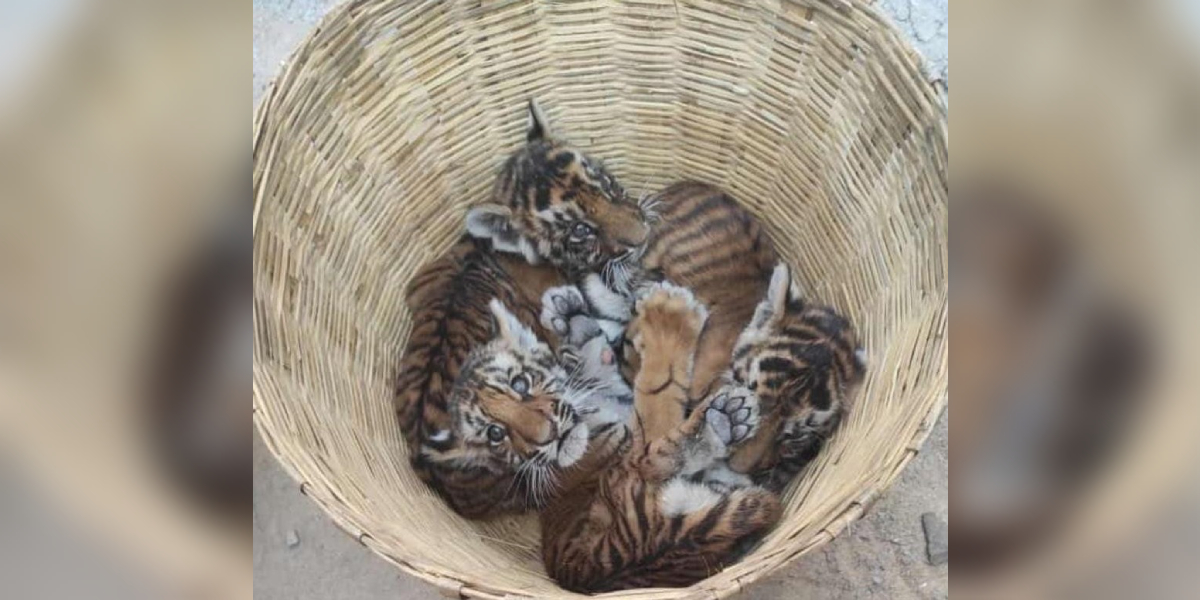The mother has been identified as an eight-year-old tigress, numbered 108. The authorities are using drones to locate her.

The tiger cubs abandoned near a village in the Nadyal district of Andhra Pradesh. (Supplied)
At least 40 camera traps have been set up by the forest authorities in the wild in and around the Pedda Gummadapuram village of the Nandyal district of Andhra Pradesh to trace a tigress so she may be reunited with her cubs.
So far, there has been no trace of the elusive large cat, which had abandoned its four cubs near the village.
Residents of Pedda Gummadapuram rescued the four female cubs at the Atmakur forest limits adjoining the village on the morning of Monday, 6 March.
To protect the cubs from predators like dogs, the villagers shifted them to a local private godown.
Later, the forest authorities arrived at the spot and shifted them to the Bairluty government veterinary hospital.
Now, the forest authorities have launched efforts to trace the mother tigress and reunite her with the cubs.
When the villagers first saw the cubs, they were terrified.
“Initially, we thought they were small cats. But, after a close look, we realised they were tiger cubs,” said a resident of Pedda Gummadapuram.
“Two of them growled when we tried to approach them. But then we shifted them into small baskets and took them to a private godown,” he added.
“We tried to feed them water and milk. But they didn’t take them. Meanwhile, we informed the forest officials and they reached us and took the cubs with them,” said the local resident.
Meanwhile, their mother has been identified as an eight-year-old tigress, numbered 108. The authorities are using drones and other methods to locate her.
“These cubs must be above two months. They are healthy. The mother tigress might have kept the cubs in one place and gone hunting for food and lost her way,” Atmakur Divisional Forest Officer (DFO) Alan Chong Teron told South First.
“Now, we have set up at least 40 camera traps in the Atmakur forest range, especially in and around where the cubs were found, to trace the tigress,” said Teron, who is also the deputy director of the Nagarjuna Sagar Srisailam Tiger Reserve (NSTR).
“So far there has been no trace of the mother tigress. We will wait for a few days and later proceed as per the standard operating procedure (SOP) guidelines set by National Tiger Conservation Authority (NTCA) in such cases,” he added.
As per the protocol and SOP, a committee for technical guidance and monitoring on a day-to-day basis has been constituted.
The committee has been set up with the local DFO as the in-charge chairman.
The committee has people nominated by the chief wildlife warden and National Tiger Conservation Authority.
It also has a veterinarian, a representative of a local NGO, and one of the local panchayat.
“We will wait for a few days to trace the mother tigress by using the camera traps. Accordingly, we will take a call after the chief wildlife warden takes a final decision on whether the cubs would be released back into the wild or transferred to a zoo,” the DFO said.
The re-wilding process — the imparting of the skills the cubs would need to survive there — should be carried out for at least two years before they are released into the wild, said another senior forest official.
As per the NTCA-prescribed SOP, two tiger cubs can be housed in the larger portion of the natural in-situ enclosure, initially for a period of two months.
Subsequently, they should be housed in separate areas of the enclosure having natural prey and cover.
“Under no circumstances should tiger cubs of the opposite sex be reared together. The tiger cubs should be reared in the in-situ enclosure for a minimum of two years, and each cub should have a successful kill record of at least 50 prey animals, since the re-wilding process requires time,” said the senior forest official.
The tiger cubs that have a successful kill record may be released in the wild — in consultation with the NTCA and after radio-collaring — to a suitable, productive habitat within the same landscape, while considering the land tenure dynamics of tigers and the presence of human settlements in the new area.
Interestingly, the people responsible for handling the cubs must approach them by putting on a tiger mask along with workday clothes with a tiger-stripe pattern smeared with tiger urine and faeces to minimise imprinting — the phenomenon where animals begin to consider their non-species handlers as their mother or guardian.
The Atmakur forest range comes under Nagarajunasagar Srisailam Tiger Reserve. It is estimated to have at least 75 tigers.
The NSTR is located in the Nallamala hill ranges, which is an offshoot of the Eastern Ghats in Andhra Pradesh.
It attained the status of a tiger reserve in 1983. NSTR spreads across the Prakasam, Nandyal, and Palnadu Districts of Andhra Pradesh.
The total area of the reserve, including the core and buffer, is 3727.82 square kilometres. It is India’s largest tiger reserve.
Two wildlife Sanctuaries — the Rajiv Gandhi Wildlife Sanctuary and the Gundla Brahmeswaram Wildlife Sanctuary (GBM) — constitute the tiger reserve.

Jul 26, 2024

Jul 25, 2024

Jul 24, 2024

Jul 24, 2024

Jul 24, 2024

Jul 23, 2024